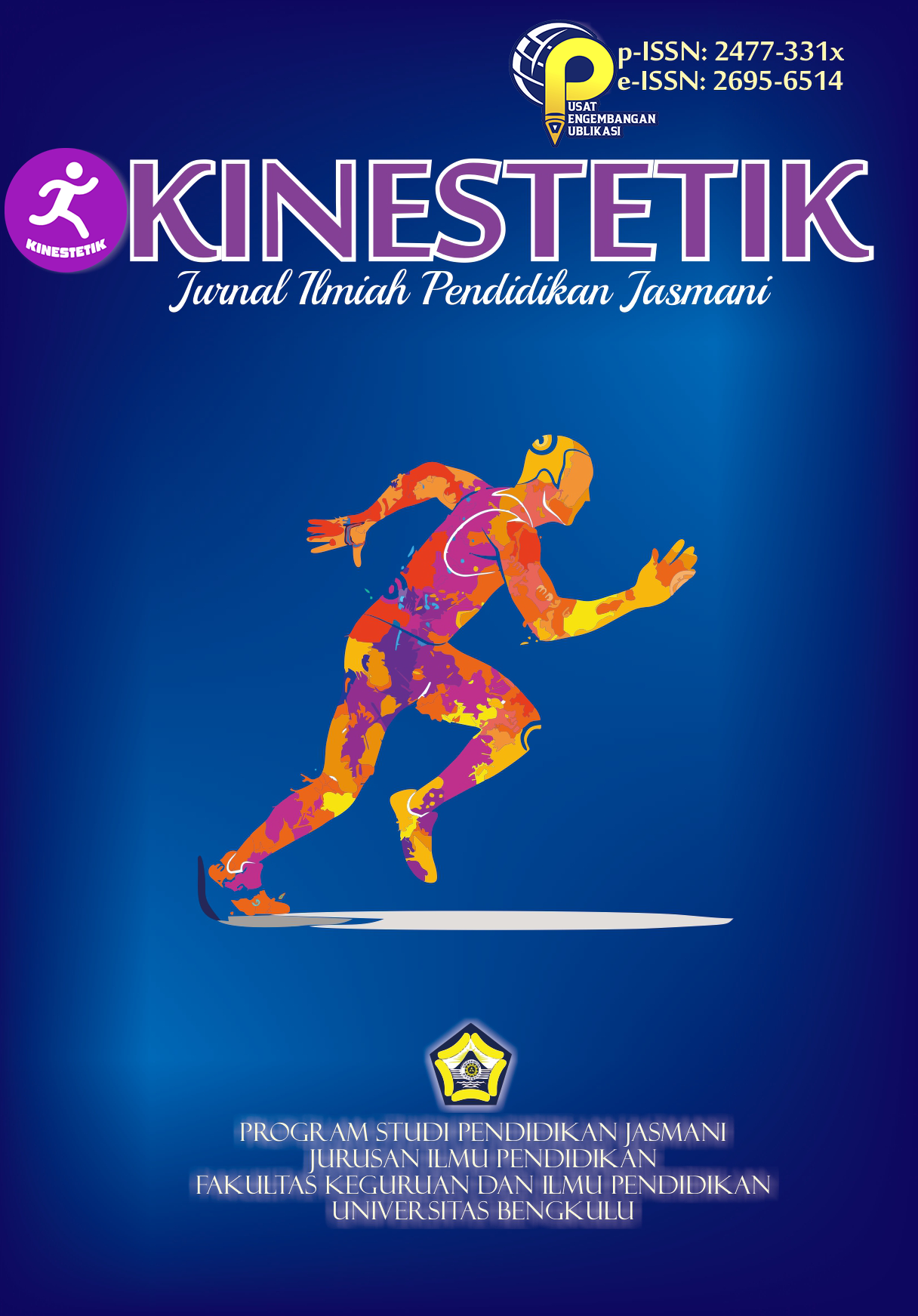Main Article Content
Abstract
This study aims to facilitate Physical Education Study Program students with the renewal of learning media based on the kinovea application, especially in biomechanics courses which not only learn theoretically but have elements of measurement and analysis of motion in humans, this study uses research and development methods using bolt and galt designs. 8 stages. The subjects of this study were physical education students in semester 5, the results showed that the level of validation of learning media from material experts and media experts was 4.13 eligible categories and 3.3 eligible categories. The results of the small scale trial show an average value of 4.1 with the Eligible category. The results of large scale trials show an average value of 3.45 in the appropriate category. Based on the results at the validation stage and small-scale and large-scale trials, this study resulted in a kinovea application-based learning media in the biomechanics course of the Bengkulu University physical education study program.
Keywords
Article Details
Copyright (c) 2023 Andika Prabowo, Dian Pujianto, Septian Raibowo, Defliyanto Defliyanto, Yarmani Yarmani

This work is licensed under a Creative Commons Attribution-ShareAlike 4.0 International License.
Authors who publish in this journal agree with the following terms:- Authors retain copyright and grant the journal right of first publication with the work simultaneously licensed under a Creative Commons Attribution-ShareAlike 4.0 (CC BY-SA) that allows others to share the work with an acknowledgement of the work's authorship and initial publication in this journal.
- Authors are able to enter into separate, additional contractual arrangements for the non-exclusive distribution of the journal's published version of the work (e.g., post it to an institutional repository or publish it in a book), with an acknowledgement of its initial publication in this journal.
- Authors are permitted and encouraged to post their work online (e.g., in institutional repositories or on their website) prior to and during the submission process, as it can lead to productive exchanges, as well as earlier and greater citation of published work (See The Effect of Open Access).
- This work is licensed under a Creative Commons Attribution-ShareAlike 4.0 International License.
References
- Adegbija, M. v, & Fakomogbon, M. A. (2012). Instructional Media in Teaching and Learning: A Nigerian Perspective. Global Media Journal African Edition, 6(2), 216–230. http://globalmedia.journals.ac.za
- Clarita, N., Raibowo, S., Prabowo, A., & ... (2021). Peran guru pendidikan jasmani dalam pelaksanaan sekolah siaga bencana pada kawasan pesisir pantai. Altius: Jurnal Ilmu …, 10(2), 143–154. https://ejournal.unsri.ac.id/index.php/altius/article/view/14718
- Dwiyogo, W. (2010). Dimensi Teknologi Pembelajaran Pendidikan Jasmani & Olahraga. Wineka Media.
- Dwiyogo, W. (2014). Analisi Kebutuhan Pengembangan Model Rancangan Pembelajaran Berbasis Blended Learning (PBBL) Untuk Meningkatkan Hasil Belajar Pemecahan Masalah. Jurnal Pendidikan Dan Pembelajaran (JPP), 21(1), 71–78.
- Danim, S. (1995). Media Komunikasi Pendidikan. Bumi Aksara.
- Dwikat, B., Joudallah, H., & Khader, W. (2018). " The Effect of using one of the Multimedia in Developing Teaching Skills for Practical Education Studentsin Faculty of Sport Eduation ". IOSR Journal of Sports and Physical Education (IOS-JSPE), 5(2), 10–14. https://doi.org/10.9790/6737-05021014
- Dwiyogo, W. (2014). Analisi Kebutuhan Pengembangan Model Rancangan Pembelajaran Berbasis Blended Learning (PBBL) Untuk Meningkatkan Hasil Belajar Pemecahan Masalah. Jurnal Pendidikan Dan Pembelajaran (JPP), 21(1), 71–78.
- Falahudin, I. (2014). Pemanfaatan Media dalam Pembelajaran. Jurnal Lingkar Widyaiswara, 1(4), 104–117. www.juliwi.com
- Fernández-González, P., Koutsou, A., Cuesta-Gómez, A., Carratalá-Tejada, M., Miangolarra-Page, J. C., & Molina-Rueda, F. (2020). Reliability of Kinovea® software and agreement with a three-dimensional motion system for gait analysis in healthy subjects. Sensors (Switzerland), 20(11). https://doi.org/10.3390/s20113154
- Heinich, R., Molenda, M., Russell, J., & Smaldino, Sharon. (2012). Instructional Media and Technology for Learning. International Journal of Distributed and Parallel Systems, 3, 8.
- Juniu, S. (2011). Pedagogical Uses of Technology in Physical Education. Journal of Physical Education, Recreation & Dance, 82(9), 41–49. https://doi.org/10.1080/07303084.2011.10598692
- Kavita, V., Sharma, J. P., & Tiwari, R. K. (2013). Use of Information Technology in Physical Education and Sport. International Journal in Multidisciplinary and Academic Research (SSIJMAR), 2(4), 2278–5973. http://ssijmar.in/vol2no4/vol2 no4.5.pdf
- Manovic, L. (2002). The Languange of New Media. MIT Press.
References
Adegbija, M. v, & Fakomogbon, M. A. (2012). Instructional Media in Teaching and Learning: A Nigerian Perspective. Global Media Journal African Edition, 6(2), 216–230. http://globalmedia.journals.ac.za
Clarita, N., Raibowo, S., Prabowo, A., & ... (2021). Peran guru pendidikan jasmani dalam pelaksanaan sekolah siaga bencana pada kawasan pesisir pantai. Altius: Jurnal Ilmu …, 10(2), 143–154. https://ejournal.unsri.ac.id/index.php/altius/article/view/14718
Dwiyogo, W. (2010). Dimensi Teknologi Pembelajaran Pendidikan Jasmani & Olahraga. Wineka Media.
Dwiyogo, W. (2014). Analisi Kebutuhan Pengembangan Model Rancangan Pembelajaran Berbasis Blended Learning (PBBL) Untuk Meningkatkan Hasil Belajar Pemecahan Masalah. Jurnal Pendidikan Dan Pembelajaran (JPP), 21(1), 71–78.
Danim, S. (1995). Media Komunikasi Pendidikan. Bumi Aksara.
Dwikat, B., Joudallah, H., & Khader, W. (2018). " The Effect of using one of the Multimedia in Developing Teaching Skills for Practical Education Studentsin Faculty of Sport Eduation ". IOSR Journal of Sports and Physical Education (IOS-JSPE), 5(2), 10–14. https://doi.org/10.9790/6737-05021014
Dwiyogo, W. (2014). Analisi Kebutuhan Pengembangan Model Rancangan Pembelajaran Berbasis Blended Learning (PBBL) Untuk Meningkatkan Hasil Belajar Pemecahan Masalah. Jurnal Pendidikan Dan Pembelajaran (JPP), 21(1), 71–78.
Falahudin, I. (2014). Pemanfaatan Media dalam Pembelajaran. Jurnal Lingkar Widyaiswara, 1(4), 104–117. www.juliwi.com
Fernández-González, P., Koutsou, A., Cuesta-Gómez, A., Carratalá-Tejada, M., Miangolarra-Page, J. C., & Molina-Rueda, F. (2020). Reliability of Kinovea® software and agreement with a three-dimensional motion system for gait analysis in healthy subjects. Sensors (Switzerland), 20(11). https://doi.org/10.3390/s20113154
Heinich, R., Molenda, M., Russell, J., & Smaldino, Sharon. (2012). Instructional Media and Technology for Learning. International Journal of Distributed and Parallel Systems, 3, 8.
Juniu, S. (2011). Pedagogical Uses of Technology in Physical Education. Journal of Physical Education, Recreation & Dance, 82(9), 41–49. https://doi.org/10.1080/07303084.2011.10598692
Kavita, V., Sharma, J. P., & Tiwari, R. K. (2013). Use of Information Technology in Physical Education and Sport. International Journal in Multidisciplinary and Academic Research (SSIJMAR), 2(4), 2278–5973. http://ssijmar.in/vol2no4/vol2 no4.5.pdf
Manovic, L. (2002). The Languange of New Media. MIT Press.
